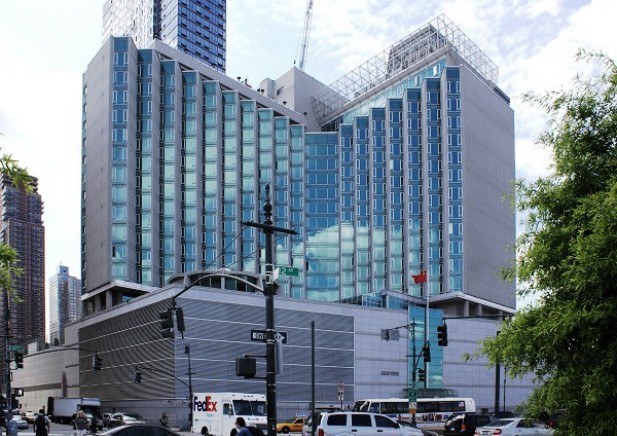In Part I of this Old New York fire cat tale, we left off at the the car stables of the Forty-second-Street and Grand Street Ferry Railroad, on the east side of Twelfth Avenue at the foot of 42nd and 43rd streets. It is the night of June 12, 1886, and about a dozen cats are fighting for their lives as a large fire burns their home to the ground…
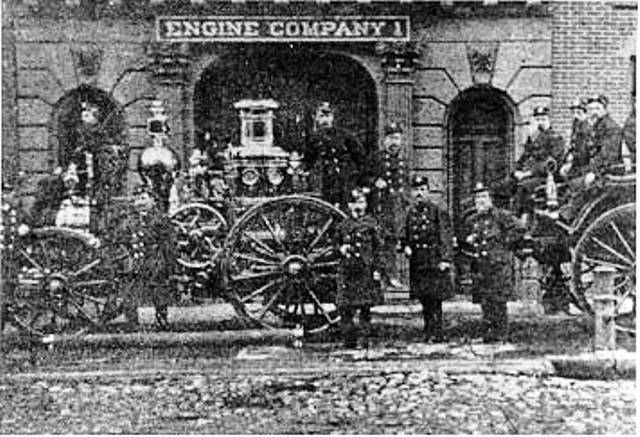
The Rescued Cats of the Green Line Car Stables
From the June 14, 1886, issue of The New York Times:
Rescued cats were a drug in the market at the Forty-second-street fire early yesterday morning. The car stables seemed alive with them when the fire was under control, and a half dozen firemen each got a cat. They were scorched, drenched, and thoroughly frightened animals when the firemen took them in charge.
How they had managed to stay in the burning building for the two or three hours they must have been there before falling walls and floors sent them scurrying out of the doors into Forty-second-street without being burned to death is a mystery that even the firemen cannot solve.
Of all the cats saved by the firemen, there was one feline in particular that evidently had at least 10 lives. This kitty, later named Hero the fire cat by the men of Engine Company No. 1, was rescued by Assistant Chief John McCabe.
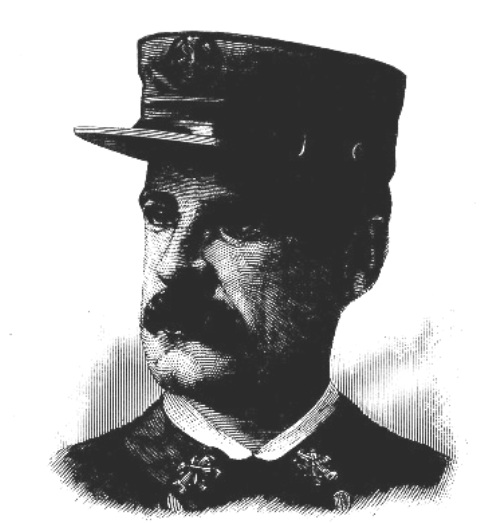
According to the Times, the tabby had been seen lurking behind a chimney on top of the wall on 42nd Street just after the roof had collapsed. As the firemen approached her, she ran quickly along the wall toward the river, trying to limit the amount of time her paws had to land on the very hot bricks.
At one point she tried to jump from the wall to a telegraph pole, but instead she scurried along to a portion of the wall nearest the river, where the bricks were cooler. When the firemen found her again, they directed a stream of water against the wall below her in an effort to cool off the bricks. This only frightened her more, causing her to hide in space in the wall.
The tabby continued to hide for about an hour, until the firemen were forced to direct their hoses toward her once again to extinguish some flames in the area. Everyone had assumed the poor cat had roasted to death, but when the water hit the wall she jumped out of her hiding spot and tried to escape again.
About five minutes later, “a forlorn-looking cat with her hair well singed off” jumped from a window on 43rd Street. Assistant Chief John “Bucky” McCabe caught her, and, wrapping her up tenderly, turned her over to the care of one of the firemen from Engine Company No. 1.

The men immediately brought the kitty to their engine house and treated her burned and blistered paws with liniment and tender care. According to news accounts, by the next day, the fire cat the men named Hero was recovering, and her paws “were resuming something like their normal condition.”
The Firehouse at 165 West 29th Street
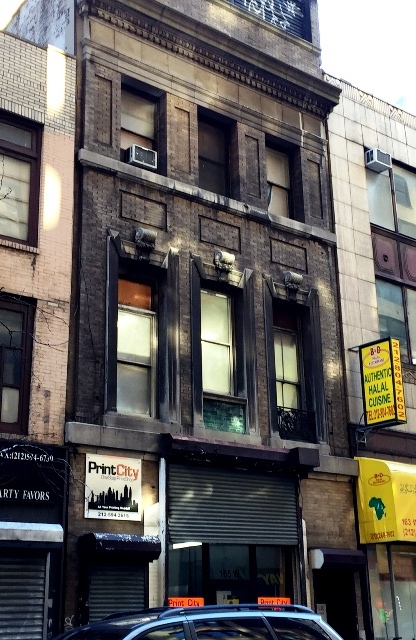
Metropolitan Steam Fire Engine Company No. 1 was organized on July 31, 1865, at 4 Centre Street (northeast corner of City Hall Park), in the former headquarters of the Exempt Engine Company, a reserve corps that was composed exclusively of exempt members of New York’s volunteer fire department. (The Exempt Engine Company was organized on November 14, 1854, at the home of H.B. Venn at 298 Bowery, a building with a very interesting history.)
On February 17, 1873, Engine Company No. 1 was reorganized at 165 West 29th Street (first photo above). A new firehouse at this same location was constructed in 1881 (photo at right). The firemen stayed at this location until 1946, when they moved to 142 West 31st Street, where today they share quarters with Ladder Company 24. (Incidentally, Father Mychal Judge was the fire chaplain at this firehouse until he became the first officially recorded victim of the September 11, 2001. attacks.)
The firehouse on West 29th Street was constructed on what had once been the estate of James A. Stewart. Stewart was a wine merchant who had a country seat along what was once called Stewart Street, a diagonal street that intersected his property bounded by 29th and 31st streets, the Bloomingdale Road (Broadway), and the Fitz Roy Road (near today’s 8th Avenue).
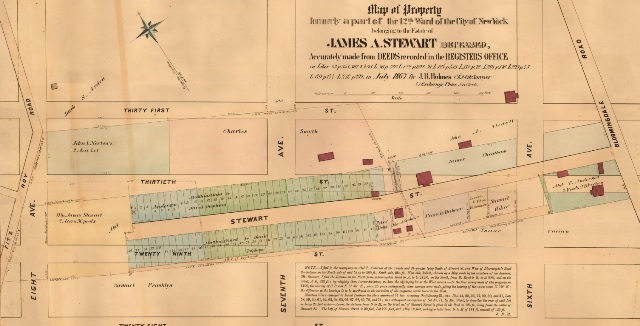
In 1809, James A. Stewart advertised for sale or lease “a very convenient country seat” and about 71 lots (each 25 feet x 100 feet) along Stewart Street. According to the ad, the home was very roomy, and featured four rooms on the first floor, fireplaces, a coach house, stable, about two acres of mowing ground or pasture, a garden with fruit trees, a good well, and “a cistern that never fails.” The ad also boasted that Stewart Street would be “the handsomest road in the city,” as it was 58 feet wide and featured two rows of trees.
In 1810, Stewart asked the Common Council to accept Stewart Street as a public road. But Street Commissioner Samuel Stillwell said that the diagonal road might interfere with the the new grid plan then under consideration (the Commissioners’ Plan of 1811).
Stewart Street remained as just stakes in the ground until it was eventually reorganized into conventional lots. However, the buildings on the north and south sides of 30th Street between 6th Avenue and Broadway still follow the original diagonal, as one can see in Google Earth:
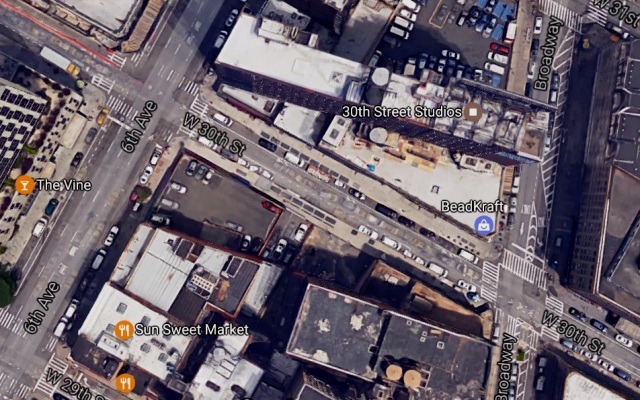
The Demise of Deputy Chief John McCabe
John McCabe, better known as Bucky, was a printer by trade who started his long career with New York City’s fire department as a runner for Oceanus Engine Company No. 11 at 99 Wooster Street. He joined the city’s new paid fire department in September 1865, was promoted to Battalion Chief in 1881, and to Second Assistant Chief in 1884. By the time he retired due to health reasons in 1893, he was Deputy Chief of the department.

On the morning of April 25, 1895, John Bucky McCabe left his home at 78 Washington Place, bought a revolver and a pack of cartridges, and walked over to the John E. Milholland Club at 111 Clinton Place (today’s 8th Street). John was president of the political club, which had been founded in 1893 to fight the “Platt Machine” and “Boss Platt” (Thomas C. Platt), the reportedly corrupt leader of the Republican Party in New York State.
At 12:15 p.m., after talking with some friends in the club for about an hour, John McCabe walked into the back room and shot himself in the head. According to news reports, McCabe had been privy to corrupt activity and so he chose to end his life rather than testify and implicate his close friends (including state senators and officers in the fire department).
As General O.J. LaGrange, president of the Board of Fire Commissioners, told the press during the hearings on April 28, “He had been trusted by his associate, or some of them, with things that he could not tell. He expected to be called before this committee. He had Irish blood In his veins, and could not be an Informer.”
The Demise of Hero the Cat

Three months after McCabe’s death, on July 16, 1895, a fire started in the cellar of the firehouse at 165 West 29th Street. Nearly all the members of the company were in the firehouse at the time, including another man by the name of McCabe — Engineer Thomas McCabe.
Although the men were able to save the horses and the fire apparatus, two gray cats that made their home in the cellar perished in the fire. I can’t say for sure that one of these cats was Hero, but one has to note the irony.
The Car Barns Burn Again
On March 4, 1906, the rebuilt car barns at the foot of West 42nd Street were destroyed in another spectacular fire. This fire was way more devastating then the one 20 years earlier; one man was killed and the fire forced the evacuation of hundreds of residents in nearby tenements and patrons at the adjacent Terminal Cafe and Annex Hotel.
Once again the car barns were rebuilt (see photo below), but sometime before 1941 the building was demolished, leaving an empty 27,000 square foot lot. That year the lot was leased by a syndicate that planned to operate a large gas station on the site.
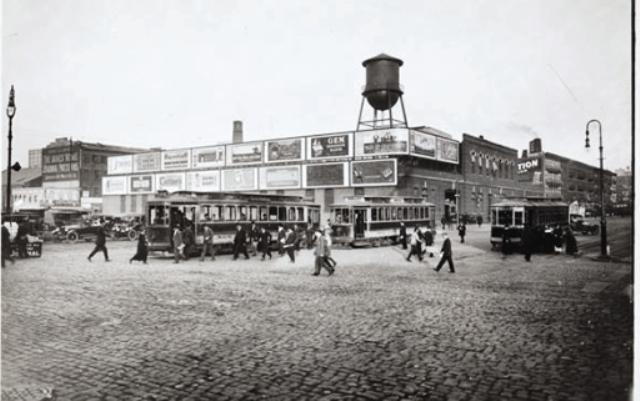
Today, the site where a tabby fire cat named Hero was rescued from a fire in 1886 is occupied by the Consulate General of the People’s Republic of China in New York at 520 12th Avenue (constructed in 1962).
